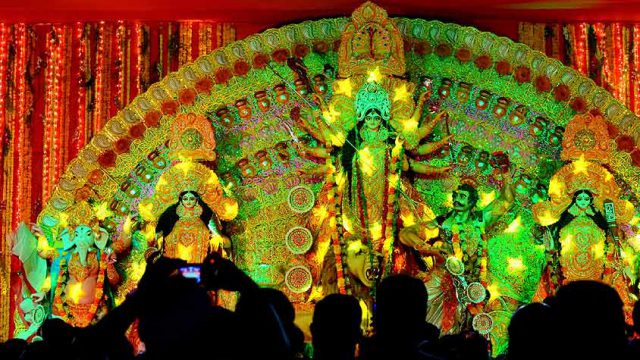Traditionally, the four days of Durga Puja, the biggest festival in the world for Bengalis, no matter where they live, have four different moods. Saptami is full of good cheer and happy anticipation. Ashtami is when the frenzied Puja mood reaches its peak and the best new clothes come out of the closet. Nabami sees a few crestfallen faces, since it is the last day, but also a brave attempt to make the most of the festivity that remains. Dashami is when the tears flow, the pots of vermillion (sindoor) come out and Durga is given the send-off (bisarjan) for her return journey to Kailash Parbat.
Every major city in India has its own Durga Puja hub. In Delhi, the centre of action is Chittaranjan Park, the ‘Bengali ghetto’ as some like to call it affectionately, though the Durga Puja celebrations on Minto Road, in central Delhi, and the now established satellite township of Dwarka in the west have their own fan following. The Minto Road Durga Puja has its platinum jubilee this year, so a visit is well worth it. Chittaranjan Park, being a mini-Kolkata, has several Durga Puja mandaps, large and small. The ones not to miss are at the Kali Bari, the B Block puja and the one near Market 2. The bhog queue at the Market 2 Durga Puja is a very, long snaking one – you know it’s going be something special.
In Mumbai, the two major Durga Pujas are at Shivaji Park and Andheri Lokhandwala. The puja on the Bengal Club grounds, at Shivaji Park, is the more traditional one, established by the Bengalis who first settled in Mumbai in large numbers. This Durga Puja has been held here since the mid-1950s; before this, for several years, the puja venue used to be rotated between Parel, Dadar and Shivaji Park. The Lokhandwala puja is the one coated in glamour, with its many celebrity participants, including singer Abhijit Bhattacharya, who is a leading organiser, and film stars Kajol, Rani Mukherjee and Bipasha Basu. Mumbai insiders say that the largest gathering of Bengalis is at the Podar School puja, organised by the Mukherjee family.
In Chennai, the Durga Puja organised by the South Madras Cultural Association, Besant Nagar is among the most renowned. Thousands turn up for the bhog distribution at this puja, which is over three decades old.
And in Kolkata, well, Durga Puja is everywhere. There is no one best puja in the city, though there’s stiff competition between the pujas in north and south Kolkata to claim the top spot. If you happen to be in Kolkata right now and have only a little time to see a few puja mandaps, the most artistic ones are not necessarily the largest or the most famous. The small puja at Ahiritola, in north Kolkata, will take your breath away with its artistry, while big names like College Square and Mohammed Ali Park impress with their scale and craftsmanship, but less so with innovation. The puja at Kumartuli, the famed potter’s colony in north Kolkata, is magnificently creative, just as you would expect – a few years ago, organisers of this Puja had created an alien planet landscape, with a domed sky and stars overhead, while the idols were placed on rock formations. The jaw dropped from every face that stepped into this universe.
In south Kolkata, the Samajsebi Sangha puja has carved a niche for itself with its consistently high quality and quirky ideas of mandap design. One Durga Puja that has stunned visitors year after year with its extraordinarily intricate mandap and idol design is the Shibmandir puja near the Lake.
A fun part of the puja celebrations is making a checklist of the mandaps to be visited and planning the best routes for seeing them. Even more fun is discovering a really beautiful little mandap tucked into a lane, like a hidden jewel. However, Durga Puja is not just something to see; it’s a state of mind. To really enjoy Durga Puja, you’ve got to be prepared to marvel at its essence.




